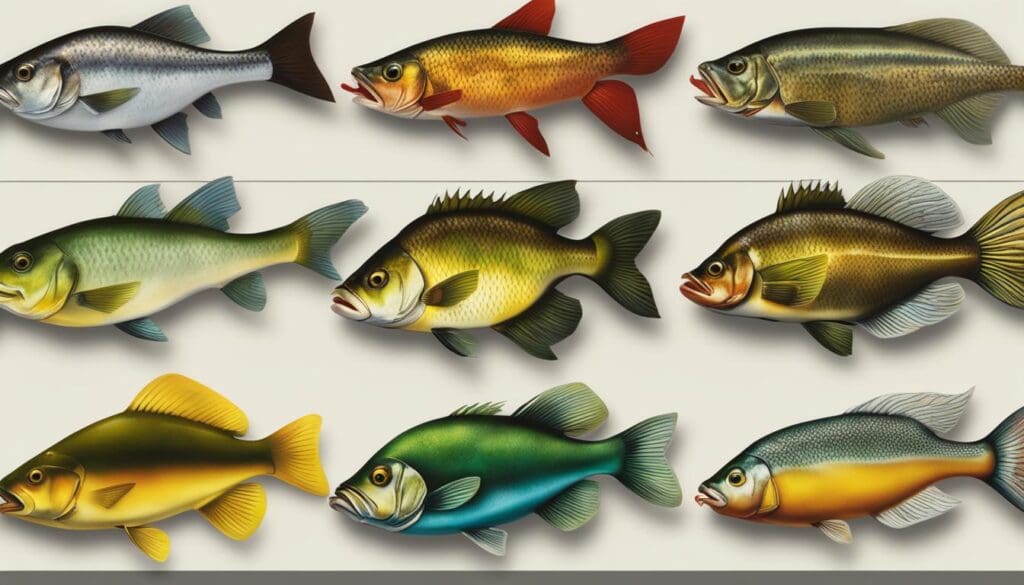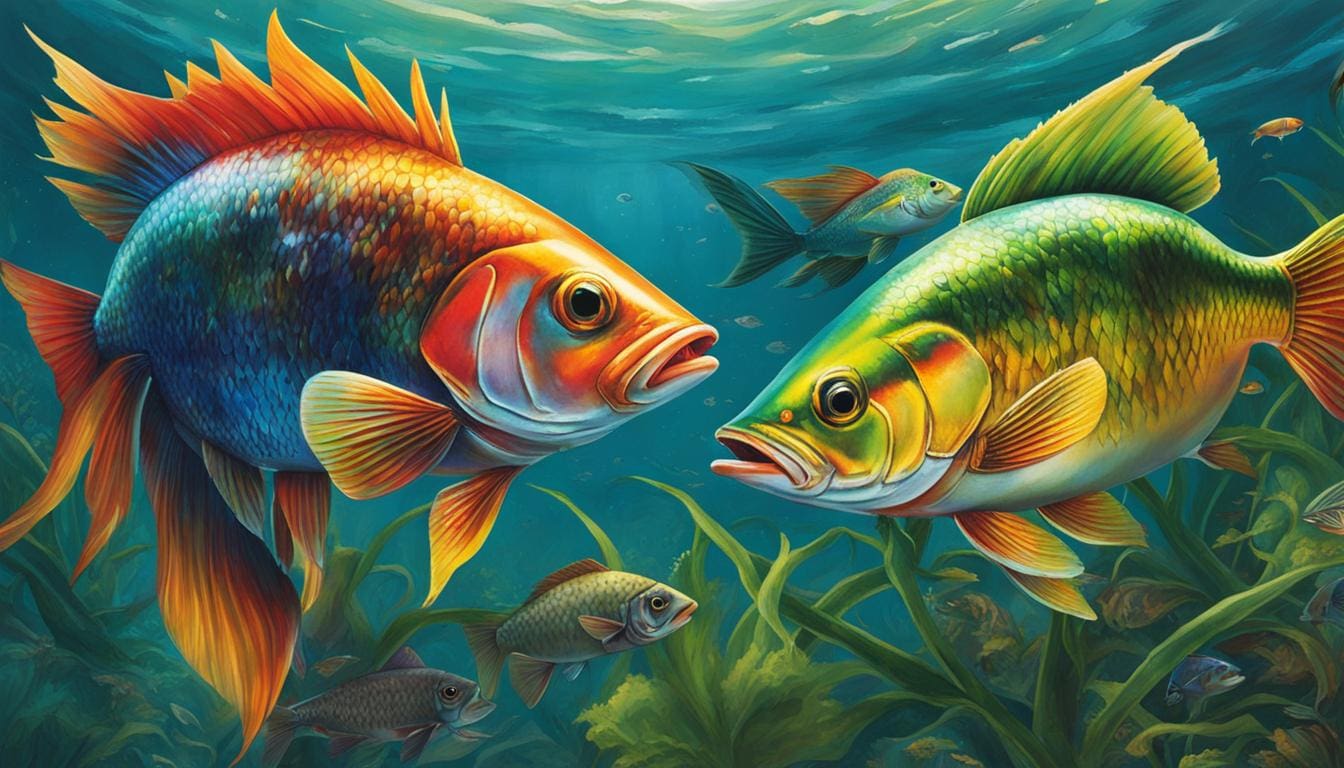When venturing into the great outdoors, whether to reel in a big catch or to combat pesky vectors, the choice of bait can be pivotal. A key to success lies in understanding the efficiency and implications of animal baits vs plant baits. Historically, anglers and vector controllers have leaned towards tried-and-tested animal-based lures, yet recent studies, including one conducted in western Kenya on malaria vectors, suggest synthetic plant odors are equally effective. This sheds light on a significant natural bait comparison, which not only affects catch rates but also points to a shift in bait type comparison.
As we delve deeper into the intricate world of fish preference for baits, a fusion of research from the fields of angling and vector control unveils new avenues. This opens the dialogue for sustainable fishing baits by presenting an array of eco-friendly bait options. With growing environmental consciousness, the weight of bait choice considerations now stretches beyond efficacy, as stakeholders are increasingly judged by the environmental impact of their practices.
Key Takeaways
- Animal and plant-based baits each offer unique advantages for fishing and vector control.
- Recent studies highlight plant-based lures like linalool oxide as effective mosquito traps.
- Sustainable and eco-friendly baits are gaining importance in the angling community.
- Understanding fish dietary preferences is essential for selecting the right type of bait.
- Environmental considerations are now as critical as the efficacy of baits.
- The debate on bait type comparison has implications for both catch rates and ecological impact.
An Introduction to Bait Types and Their Importance in Fishing
The world of fishing is diverse and complex, with each decision holding the potential to greatly impact the success of an angler’s effort. Among these decisions, the choice of bait is paramount, impacting not only the catch rate but also the sustainability of fishing practices. As we embark on this exploration of angling with different bait types, the significance of such a choice becomes increasingly clear.
Defining Bait Types: Natural, Synthetic, and Hybrid
When discussing bait diversity, it’s crucial to differentiate between the primary categories available. Natural baits are those obtained directly from the environment, such as worms or small fish, which are inherently appealing to predators. Synthetic baits, on the other hand, are man-made solutions designed to imitate natural ones. These may range from rubbery recreations of worms to complex scent-emitting devices that attract fish through chemoreception. Hybrid baits represent a fusion of both, leveraging both natural elements and artificial enhancements to attract target species. In choosing between animal and plant baits, a nuanced understanding of these categories is essential.
Understanding the Role of Baits in Fishing Ecosystems
Each bait type plays a significant role within different fishing ecosystems, aligning with the dietary habits of local species—herbivorous fish may be attracted to plant-based lures, while carnivorous ones often seek flesh-based baits. The introduction of foreign baits into a habitat can also have profound effects on its ecological balance, making bait selection strategies an elemental consideration for conservation-minded anglers.
Historical Perspectives on Bait Use Across Cultures
Historically, bait use has varied widely across cultures, evolving from the adoption of readily available natural resources to more sophisticated, angling with plant-based lures, and technologically advanced synthetic options. Indigenous populations might have used bones and pieces of fruit, while modern anglers may opt for engineered scents and flavors. This historical journey showcases a universal search for more effective baits, reflecting deeply rooted human ingenuity and adaptability.
- Natural baits are often sourced directly from the angler’s immediate environment.
- Synthetic baits are crafted to provide an imitation of natural food sources.
- Hybrid baits combine both natural and artificial elements to create a more appealing lure.
- Comparing bait efficiencies has been an ongoing endeavor, with adaptions being made as new knowledge is acquired.
As we delve deeper into the subtleties of each bait category, a pattern emerges: The ingenuity of anglers, coupled with an intimate knowledge of their quarry’s habits, can lead to more successful and ecologically sound fishing experiences.
Animal-based Bait Effectiveness in Contemporary Fishing Practices
The reliance on animal-based baits has been a steadfast tradition in the fishing world, a testament to their effectiveness in attracting and catching prey. Living in a time where angling is not just a means of subsistence, but also a sport and a form of leisure, it’s essential to focus on techniques that yield the best results. While debates continue over the effectiveness of plant-based baits, the use of natural, animal-derived lures has proven time and again to be a choice method among novices and seasoned anglers alike, owing to their instinctual appeal to various fish species.
Benefits of Using Traditional Animal Baits
Traditional animal baits such as worms and minnows are rich in scent and texture, making them an irresistible temptation for predatory fish. These baits are closely aligned with the natural prey items that fish encounter in their environment, leading to better animal lure advantages such as quicker strikes and potentially higher catch rates. The familiarity and proven track record of animal bait effectiveness make them a go-to option for many anglers looking to capitalize on their fishing excursions.
Varieties of Animal Baits and Their Target Species
Choosing the right type of animal bait is critical in appealing to the specific dietary preferences of your target species. Earthworms, for instance, are widely used for catching freshwater fish like trout and bass due to their natural abundance in aquatic ecosystems. Mollusks, another category of animal-based bait, are favored for species such as carp and catfish. These baits mirror the organic material found in these fishes’ habitats, thus optimizing the bait options for anglers. The following table provides a snapshot of common animal baits.
| Bait Type | Target Species | Environment |
|---|---|---|
| Earthworms | Trout, Bass | Freshwater |
| Mollusks | Carp, Catfish | Freshwater, Brackish |
| Minnows | Pike, Walleye | Freshwater, Marine |
| Crabs | Tarpon, Redfish | Marine |
Impact on Predatory Fish Behavior and Angling Efficiency
The behavior of predatory fish is guided by instinctual responses to prey. By using animal-based baits that mimic these natural prey items, anglers can have a direct impact on the efficacy of their fishing methods. Such baits often elicit aggressive feeding behavior, translating to higher catch rates and a more engaging fishing experience. However, due to the keen senses possessed by these aquatic hunters, the quality and freshness of the bait can significantly alter its effectiveness, hence why seasoned anglers focus on sourcing the best animal-based bait available.
- The natural movement and scent of live baits such as minnows can induce more bites.
- Preserved baits offer convenience, but may lack some effectiveness of their live counterparts.
- Understanding the feeding habits of the target species can greatly enhance angling efficiency.
In the quest to achieve higher yields and maintain the alluring sport of fishing, comprehending the nuances of animal bait selection remains a cornerstone of modern angling practices. Although the lure of plant-based bait alternatives may beckon a new era of fishing strategies, the time-tested successes of animal-derived lures continue to hold sway in today’s diverse angling community.
The Rise of Eco-friendly and Sustainable Baits: Plant-based Options

In the quest for more sustainable fishing practices, the environmental impact of bait types has come under scrutiny. This has given rise to a wave of eco-friendly bait options that aim to minimize ecosystem disruption while still providing the effectiveness anglers require. The emergence of plant-based baits is a testament to the evolving sensibilities and innovative spirits within the fishing community.
Plant bait benefits are becoming increasingly evident, both from an environmental and a functional perspective. Studies on mosquito control have shown the potential of synthetic plant odors, such as linalool oxide, not only in trapping malaria vectors but also posing as a beacon for fish seeking nourishment. These findings hint at the promising application of plant-based options in fishing scenarios.
As global awareness grows, so does the popularity of sustainable fishing baits. Anglers are turning to plant-derived solutions that align with their conservation goals and lifestyle choices. Here’s an overview of plant-based baits that spotlight their appeal and applications:
- Renewability: Plant baits can be sourced from renewable resources, ensuring a continuous supply without depleting wildlife populations.
- Biodegradability: Unlike some synthetic or plastic baits, plant-based options decompose naturally, reducing potential water pollution.
- Appeal to Diverse Species: Research suggests certain plant odors are universally attractive to various fish species, much like they are to insects.
- Catch and Release: Eco-friendly baits can be particularly suitable for catch-and-release scenarios, where maintaining fish health and habitat is crucial.
To further elucidate the practicality and relevance of these baits, consider the following table comparing key attributes of plant-based baits against traditional bait types:
| Attribute | Traditional Animal Baits | Plant-Based Baits |
|---|---|---|
| Eco-Impact | Higher potential for ecosystem disruption | Lower ecological footprint |
| Renewability | Often dependent on wildlife populations | Derived from sustainable plant growth |
| Biodegradability | Varies with bait type | Highly biodegradable |
| Universal Appeal | Specific to certain fish diets | Potentially wide-ranging attractant properties |
The transition to eco-friendly bait options like plant-based alternatives is not only a reflection of an environmental ethos but also an adaptive response to a growing need for sustainable fishing baits. As we navigate towards a more responsible future, the innovations within the realm of bait types play an integral role in preserving aquatic life and fostering a balanced ecosystem.
Comparing Bait Efficiencies: Analyzing Catch Rates
When fishing and conducting vector control, assessing the effectiveness of the baits used profoundly influences outcomes. Thoroughly comparing bait efficiencies is essential to understand whether the use of animal-based baits or their plant-based counterparts provides better results. Studies exploring these efficiencies, particularly in terms of catch rates, help to guide strategic decisions in both recreational fishing and managing disease-carrying vectors.

Statistical Evidence from Field Studies
In the analysis of bait efficacy, it’s pivotal to examine real-world data. Field studies serve as a critical foundation in ascertaining the effectiveness of plant-based baits versus those derived from animal sources. One milestone study conducted in western Kenya revealed fascinating insights into the use of synthetic plant odors. Conducted over a span of 18 days, the study shed light on how plant-based lures performed in trapping malaria vectors, setting a precedent for bait type comparison outside traditional applications.
Success Rates: Animal vs Plant-based Baits
The Kenyan research, focusing on species like Anopheles gambiae, traditionally targeted by animal-based lures, showcased that synthetic plant odors may rival the animal-based bait effectiveness traditionally employed. Odors like linalool oxide, when utilized adequately, could match or even enhance the success rates of baiting and trapping, a revelation that calls for rethinking using the effectiveness of plant-based baits in controlled environments and potentially extending these approaches into the broader sphere of angling.
Scientific Perspectives on Bait Preferences of Fish Species
The insights from this emerging field of study align with the nuanced knowledge required in determining optimal baiting strategies for fish. A scientific perspective on bait preferences of fish species, influenced by their natural diets and behavioral tendencies, signals an expanding exploration in bait efficiency comparison. These field studies, critical in testing bait effectiveness for trapping vectors, also prompt a reevaluation of angling practices, beckoning a new wave of research into what draws diverse fish species to different bait types.
| Bait Type | Efficacy in Field Studies (Mosquito Capture) | Potential for Fish Capture |
|---|---|---|
| Synthetic Plant-Based Odors | Comparable to Animal-based Baits | Under Investigation |
| Animal/Human-Based Synthetic Lure | Effective | Traditionally Favored |
| Combined Plant and Animal Odors | Mixed Results (Specific Combinations) | Requires Further Research |
Fish Preference for Baits: Understanding Aquatic Diets
Anglers and researchers alike have long been fascinated by the intricate details of aquatic diets and fish preference for baits. As we strive to optimize our approach to both sport fishing and ecosystem management, it becomes imperative to analyze and understand the complex tapestry of bait choice considerations. Insights into the dietary habits of piscine species enable us to tailor our bait selection to maximize effectiveness and sustainability. This exploration seeks to dissect bait diversity in aquatic diets and establish a clear natural bait comparison.
Herbivorous, Omnivorous, and Carnivorous Fish in the Wild
Each fish species has evolved unique dietary tendencies that directly influence their affinity for certain baits. Herbivorous fish, for instance, graze on plant life, making them more responsive to baits such as algae-based pellets and vegetable fragments. On the other end of the spectrum, carnivorous fish hunt other aquatic animals, showing a clear predilection for meaty offerings such as live or dead prey fish. Omnivorous species present the most flexible palette, often switching between plant and animal baits based on availability and seasonality.
Natural Diet Adaptations in Marine and Freshwater Environments
Both marine and freshwater environments dictate specific dietary adaptations unique to their inhabitants. For example, freshwater ecosystems often comprise an abundance of insect life, which is readily exploited by both juvenile and adult fish. In contrast, the marine realm provides a broader variety of prey, from microscopic plankton to large squids, affecting the bait diversity in aquatic diets that ocean-going fish might prefer.
The following table provides insight into the bait preferences of different fish based on their natural diets:
| Fish Type | Preferred Natural Bait | Typical Environment |
|---|---|---|
| Herbivorous Fish | Plant-based baits (algae, vegetables) | Marine and Freshwater |
| Omnivorous Fish | Versatile baits (insects, fruits, small fish) | Primarily Freshwater |
| Carnivorous Fish | Animal-based baits (live baitfish, crustaceans) | Marine and Freshwater |
| Opportunistic Feeders | Mix of plant and animal baits | Transition Zones/Estuaries |
While the traditional view suggests that carnivorous and omnivorous fish might be keener on animal-based baits, the recent study on Anopheles species trapping in Kenya suggests that plant-based lures can also play a significant role in bait choice considerations. This implies an exciting avenue for experimentation and potential crossover in baits, even within the fishing community.

To conclude, understanding the bait preferences derived from fish’s natural diets provides a discerning angler with valuable insights into bait diversity within aquatic diets. Making informed decisions based on these preferences and the type of aquatic environment can greatly increase angling success and contribute to more ecologically mindful fishing practices.
Environmental Impact: Plant and Animal Bait Types
The pursuit of sustainable fishing methods has brought to light the tangible environmental impact of bait types. Plant and animal bait – each holding a unique ecological footprint – influence fishing practices and conservation measures. This discussion anchors on the broader canvas where sustainable fishing baits and eco-friendly options interweave with the principles of responsible angling.
The burgeoning interest in eco-friendly bait options directly correlates to the emphasis on reducing carbon emissions and protecting aquatic ecosystems. Simultaneously, the conservation-driven angling practices are reshaping old traditions to align with modern environmental ethos.
The Carbon Footprint of Bait Production
The production of baits reflects a spectrum of environmental footprints. Animal baits, reliant on livestock or wild catch, inherently carry a heavier carbon footprint. The processes of growing feed, maintaining fisheries or farms, and bait transportation all add up to higher CO2 emissions.
In contrast, sustainable fishing baits sourced from plant material usually tout a lower carbon output. From cultivation to harvest, the CO2 emissions are markedly lower, and the practices often involve less invasive methods, which supports the premise of sustainable fishing practices and conservation.
Ecosystem Disruption vs. Conservation-Driven Angling Practices
An important facet of the conversation about fishing baits is the potential disruption to ecosystems. Traditional animal bait practices can lead to overfishing and wildlife population disturbances, adding layers of ecological dissonance. For instance, the pursuit of worms and minnows not only affects the local fauna but can also disrupt the soil and water landscapes.
Advancing conservation-driven angling practices, modern anglers are turning towards plant-based alternatives. These practices contribute to habitat preservation and offer a path towards eco-equilibrium. Notably, a pioneering study in western Kenya spotlighted the effectiveness of plant-based lures like linalool oxide, used in controlling malaria vectors. This approach, evidencing minimal environmental trespass, portends a transformative potential for fisheries management across the globe.
- Animal bait production: Often entails high carbon footprints with considerable ecological implications.
- Plant-based bait production: Represents a greener approach with inherently lower emission rates.
- Ecosystem disruption: A consequence of traditional baiting methods that can be mitigated with a shift to plants.
- Conservation-driven practices: Gain momentum as studies validate the efficacy of plant-based lures.
With the evolution of angling practices, anglers are at a crossroads with choices between efficiency and environmental stewardship. Plant-based solutions, given their eco-friendly bait options and reduced carbon footprint, are ascending as the favorable component in this delicate balance, promising a sustainable future for both the passion of fishing and the preservation of the natural world.
Animal vs Plant-based Baits: Angler Preferences and Effectiveness
As the debate between animal lure advantages and plant bait benefits continues, angles must consider not only the effectiveness of their baits but also the environmental impact and personal ethics involved in their bait choice considerations. Traditional methods leaning heavily toward animal-derived baits have been effective in achieving high catch rates and satisfying angler preferences for centuries. Innovative use of plant-based baits, however, is emerging as eco-friendly alternatives that can match the effectiveness of their animal counterparts.
Recent research into vector control has sparked interest in the potential crossover applications of plant-based attractants in fishing. Notably, plant odors such as linalool oxide have proven particularly effective in outdoor settings for the capture of malaria vectors like Anopheles gambiae, suggesting their adaptability and utility can extend to angling.
Consequently, the comparison between these two bait types is not only about catching fish but also about adopting more sustainable practices that align with growing environmental consciousness among anglers.
- Animal-based baits have historically provided high catch rates.
- Plant-based baits offer an environmentally sustainable alternative.
- Anglers must weigh personal ethics, effectiveness, and ecological factors when choosing baits.
The following comparative analysis delves into the intricacies of each bait type’s attributes:
| Criteria | Animal-Based Baits | Plant-Based Baits |
|---|---|---|
| Effectiveness for Catch | Proven historical success rates | Emerging as comparable alternatives |
| Environmental Impact | Potential disruption to ecosystems | Lower ecological footprint |
| Ethical Considerations | Concerns over live bait welfare | Alignment with conservation values |
In light of recent findings, angler preferences may gradually shift towards plant-derived options, steering the angling community towards more eco-conscious bait choices. This shift is not simply a matter of personal preference but one that has significant implications for fishing’s future sustainability.
The Practicality of Bait Choices for Modern Anglers
The contemporary angler stands at a crossroads, confronted with a diverse array of bait options that include traditional animal prey and the burgeoning field of plant-based alternatives. With the evolution in angling technology and methodology, deciding between these options takes on new dimensions. Factors such as regional availability, environmental sustainability, and cost implicate strategic choices in securing targets, whether for leisure or sport. We navigate through the complexities of choosing between animal and plant baits, punctuated by a noteworthy shift towards innovative bait solutions and embrace of DIY bait approaches for anglers.
Availability and Accessibility of Bait Types
Availability and accessibility remain decisive factors in an angler’s bait selection process. While local bait shops commonly stock live and preserved animal baits, the tendency is to capitalize on what’s readily obtainable and proven to attract the desired catch. On the other hand, plant-based baits are gaining ground, supported by research affirming their efficacy, such as the studies in Kenya using linalool oxide for vector management. This influx of plant-based options reflects an adaptive angling community that is increasingly motivated by sustainability and the availability of a wider range of baits.
Cost Analysis: Investment in Quality Bait vs. Yield
In analyzing the cost-benefit angle, modern anglers calculate the potential yield rivers and oceans promise against the investment in quality baits. Affordability may encourage the use of certain bait types over others; hence, the cost analysis stretches beyond the upfront price—it encapsulates the effectiveness of the bait in the context of seasonal migrations and habits of aquatic life. Experienced anglers discern that investing in high-quality bait can result in a higher yield, making the pursuit both economically sensible and environmentally attuned.
Innovative Bait Solutions and DIY Approaches for Anglers
The thirst for innovation within the angling community has sparked a rise in DIY bait concoctions, marrying the principles of ingenuity with cost-effectiveness. Homemade bait recipes, such as cereals transformed into doughballs or the blending of peanut butter with grains, represent a fusion of accessibility, affordability, and customizability. These DIY approaches empower anglers to tailor their bait to the specific tastes and sensors of their quarry. Through their creative tinkering, anglers can sculpt the sphere of fishing toward a more personal and potentially more gratifying art form.
FAQ
What are the different bait types used in fishing?
The main bait types used in fishing include natural baits sourced from the environment, synthetic baits engineered to mimic these natural sources, and hybrid baits that combine elements of both natural and synthetic components.
How do the preferences of fish towards various baits affect fishing?
The preferences of fish toward different baits play a crucial role in the success of fishing. Fish have evolved natural diets that may make them more inclined to go after baits similar to their usual prey, whether plant or animal-based. These preferences influence bait choice considerations, where the right bait can significantly increase catch rates.
Why are traditional animal baits so effective in fishing?
Traditional animal baits are effective because they closely resemble the natural prey of predatory fish. They trigger instinctive feeding behaviors, resulting in a higher chance of success in angling. The varieties of animal baits and their alignment with natural diets of different fish species make them a strong choice for many anglers.
How are plant-based baits becoming a viable option in sustainable fishing?
Plant-based baits are emerging as a viable option mainly due to increased environmental consciousness among anglers and the demonstrated effectiveness of plant-derived compounds like linalool oxide in other applications, such as mosquito control. These eco-friendly bait options offer a more sustainable approach to fishing with minimal ecological impact.
What evidence is there to support the effectiveness of plant baits compared to animal baits?
Field studies, like those conducted in western Kenya for mosquito surveillance, have shown that synthetic plant odors can be as effective as animal odors in trapping, suggesting that plant-based baits may provide comparable results in fishing as well. These studies are prompting further exploration into the use of plant-based baits in fisheries.
How do the diets of herbivorous, omnivorous, and carnivorous fish affect bait selection?
Bait selection is heavily influenced by the natural diets of various fish species. Herbivorous fish prefer plant material, carnivorous fish are drawn to protein-rich animal baits, and omnivorous fish might be attracted to a combination of both. Understanding these dietary preferences is essential for choosing the right type of bait to catch specific fish.
What environmental impacts should be considered when choosing between plant and animal baits?
Anglers should consider the carbon footprint and potential ecosystem disruption caused by bait production. Plant-based baits typically have a lower environmental impact compared to animal baits, which can contribute to higher CO2 emissions and ecological changes. Conservation-driven angling practices are increasingly favoring sustainable and eco-friendly bait options.
How do angler preferences influence the effectiveness of animal vs. plant-based baits?
Angler preferences are shaped by factors such as perceived effectiveness, personal ethics, and environmental impact. While traditional animal baits have been preferred for their established track record, the shift towards sustainable practices and findings from research, like those on mosquito control, could influence anglers to gravitate towards plant-based baits if they’re found to be equally effective.
What are some considerations for the practicality of bait choices for modern anglers?
Modern anglers consider practical factors such as the availability and accessibility of different bait types, cost versus yield of investing in quality bait, and innovative solutions like homemade recipes. The balance between commercial options and DIY approaches provides anglers with a variety of choices tailored to their preferences and fishing conditions.

